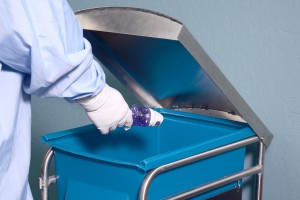
Last fall, our colleague, Paul Leonard, began a discussion on Sustainability in Medical Devices. He first laid out the definition of sustainability and the considerable challenges and opportunities inherent in applying sustainable design practices to medical devices. He went on to take a closer look at packaging and materials in order to uncover paths to create more sustainable solutions that are good for people, the planet, and the bottom line. In this article, we’ll pick up where Paul left off to close out this series by looking at what is perhaps the biggest elephant in the room—disposable medical devices.
The size of the medical disposables market is massive and still growing. According to a recent report by Freedonia Market Research Group1, “US demand for disposable medical supplies is forecast to increase 4.3 percent annually to $46.7 billion in 2016.” Another study2 found that, as of 2006, “Approximately 90 percent of medical device waste consists of disposable, one-time-use products or components.”
The increase in fears of blood-borne pathogens like HIV helped ignite the growth of the Single Use Device business model in the medical industry. It has been applied to sectors from simple syringes to complicated surgical devices. Indeed, the disposable model has many benefits. Disposables eliminate a key point of contamination, they give patients and practitioners great peace of mind, and they provide businesses a robust revenue stream. But, as we look at the full product life cycle, there are obvious downsides, as well. A great deal of virgin materials goes into disposables and this material often ends up incinerated after a single use. The challenge is to work within the single-use-device business model to increase sustainability and reduce costs, while still protecting people, planet, and profits.
Solution paths
As we look at approaches to increase sustainability in disposable medical devices, we’ll narrow our scope to eliminate simple products like band-aids and syringes, and focus on more complicated medical devices like those used in catheter lab surgeries. In this arena, there are two clear approaches for increasing the sustainability: work within the existing design framework to optimize sustainability, or rethink the design in order to remove complexity, materials, and costs from the disposable.
Optimize without Redesign.
Working within the existing architecture of a device, we can make smart choices about materials, packaging, and distribution. Thoughtful design and engineering can reduce the amount of materials required. We can use sustainable materials whenever appropriate. And, although recycling of medical devices can be limited by contamination, we can make a difference by choosing recyclable materials for packaging where possible.
Another consideration in packaging is how many items are in a single package. If several items are included in one single-use package, protocol in many operating rooms requires disposal of all of the items even if only one was used. In such cases, total waste can actually be reduced by using more packaging.3
Redesign to move the shift point.

When we look at medical disposables, devices range from self-contained units that are entirely disposable, to single use devices that are part of a larger product system. For an example of the latter, in catheter lab procedures, there may be a console that drives the system, a control unit used by the surgeon, and the operative element (e.g. angioplasty balloon or plaque removal device) which is deployed through a catheter into the patient. Today, it’s not unusual for the console to be the only element of the system that’s designed for reuse. This puts the shift point from reusable to disposable between the console and the control unit. If we can rethink the system to move this shift point by increasing the reusable elements, we can improve sustainability while greatly reducing the COGS on the disposable piece. Obviously, there are a myriad of factors to consider in such a redesign. How will electronic components handle sterilization? Can the user experience be maintained or even improved? How will sterilization and restocking affect hospital procedures? Should components have proprietary engagement to preserve market share? As in any redesign, these factors must be weighed and balanced throughout the design process.
Repurposing: Threat or Opportunity
If you doubt the need to push for more sustainable solutions in disposables, take a look at the burgeoning market for reprocessed single-use devices. In 2011, the market was $250 million per year,4 with projected growth at 9 percent a year through 2017.5 FDA regulates reprocessing and determines which devices are allowed to be prepared for re-use. The “reprocessed devices are soaked in sterilizing solutions, disassembled, blasted clean with a fine powder, reassembled and inspected, then packaged, sterilized and resealed. On average, they’re reused three to six times.”6
Hospitals are embracing reprocessing to lower costs and waste. Medical devices companies are understandably concerned about this threat to their revenue streams. Some are even buying reprocessing companies. It wouldn’t be surprising if some engineered their way around the problem by making devices harder to disassemble and reprocess or unable to withstand sterilization. A more sustainable approach would be to move the shift point between what is reusable and what is disposable. If we shift more of the complexity and materials to the reusable side of the shift point, we can still offer hospitals the win/win of lower costs and less waste.
Sustainability is hardly ever easy. But when we understand that profitability is a vital part of the sustainability equation, it’s easy to see why it’s a challenge worth embracing. By optimizing an existing design, or redesigning to minimize disposable elements we can make a significant and positive difference.
References:
- US Disposable Medical Supplies Market. Freedonia via ReportLinker.com. April 2012
- “An Environmental Guide for the Medical Device Industry of Massachusetts,” Commonwealth of Massachusetts Executive Office of Environmental Affairs (Boston: December 2006): 46. And Sustainability in Medical Device Design, by Chris Kadamus. Medical Device + Diagnostic Industry. September 1, 2008.
- Half of Hospitals Recycling at Least Some Waste. EnvironmentalLeader.com. July 7, 2010.
- Reprocessing Wars, by Dan O’Connor, Outpatient Surgery Magazine. May 2011.
- US Reprocessed Medical Device Market to Continue Strong Growth. Millenium Research Group. August 29, 2012.
- Reprocessing of Single-Use Devices: Good Idea/Bad Idea? By Tim Odell. MedGadget.com August 2006.
Additional references:
- Many Hospitals Now Safely Reuse ‘Single-Use’ Medical Devices, by Kathryn Siranosian. Triple Pundit.com. March 12th, 2010
- Sustainability Issues Looming for Designers, by Frank Esposito. Plastic News. April 25, 2011







